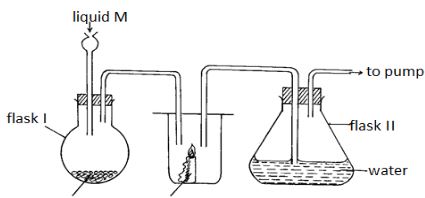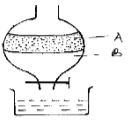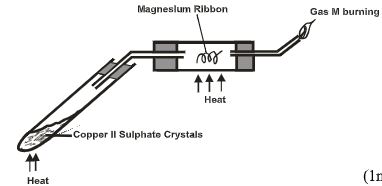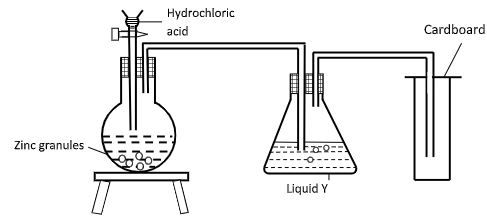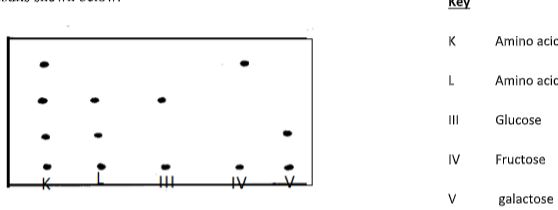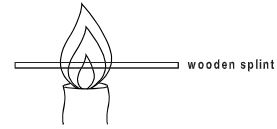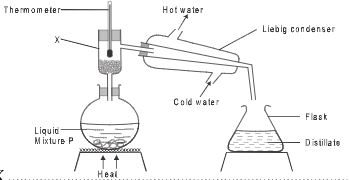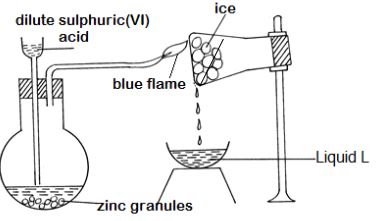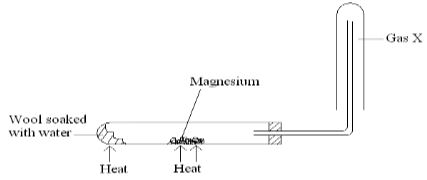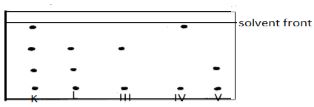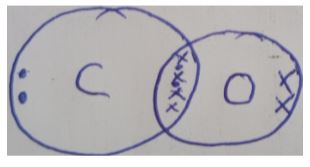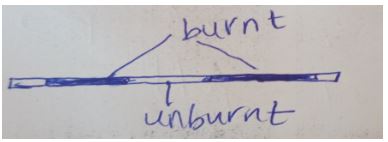- The diagram below shows a set up of apparatus used to prepare oxygen gas and pass it over burning candle. The experiment was allowed to run for several minutes.
- Identify liquid M. (1mk)
- Write an equation for the reaction that forms oxygen gas in the set up. (1mk)
- Drops of methyl orange indicator was added to solution formed in flask II . State and explain the observations made. (2mks)
- The apparatus below was used to separate a mixture of liquid A and B.
State two properties of the liquids that make it possible to separate them are using such apparatus. (2 marks) - Solid sodium carbonate was added to a solution of Aluminium chloride in a test tube.State and explain the observations made. (2mk)
- The table below shows some elements in the periodic table. Use it to answer the questions that follow. The letters are not the actual symbols of the elements.
-
- Show the electron arrangement of :
G………………………………………… (1mk)
Ion of D………………………………………. (1mk) - Write the formula of the compound formed between the elements C and G. (1mk)
- Show the electron arrangement of :
- Show on the grid above an element Y which forms an oxide with the formular Y2O3 belonging to Period 2. (1mk)
- Compare the following with explanations:
- The reactivity of A and C (2mks)
- Atomic radii of elements A and E (2mks)
- Ionization energies of elements A and C. (2mks)
- write an equation to show the effect of heat on
- nitrate of C(1mk)
- hydrogen carbonate of G (1mk)
- what name is given to the group of elements to which element G belong (1mk)
-
- Name the process which takes place when
- Iodine changes directly from solid to gas (1mark)
- Water changes to water vapour (steam) (1mark)
- Ability of a metal to be drawn into thin wires (1mk)
- The table below gives atomic numbers of elements represented by the letters A, B, C and D.
Use the information to answer the questions that follow.Element A B C D Atomic number 15 16 17 20 - Name the type of bonding that exists in the compound formed when A and D react. (1mk)
- Select the letter which represents the best oxidizing agent.
Give a reason for your answer. - Give a reason why phosphorous is stored under water. (1mk)
- Study the set up below and answer the questions that follow.
- Identify gas M. (1mark)
- Write an equation of the reaction that takes place in the combustion tube. (1marks)
- In the industrial preparation of oxygen, state:
- How dust particles are removed from air. (1mk)
- Why carbon (IV) oxide is removed before the mixture is cooled to – 25 0 C (1mk)
- Describe how a sample of pure sodium chloride can be obtained from a mixture of iodine,sodium chloride and sand. (3mks)
- The set up below was used to prepare dry hydrogen gas. Study it and answer the questions that follow.
- Identify a mistake in the set up (1mk)
- Write an equation for the reaction for the reaction that produces hydrogen gas (1mk)
- State one use of liquid Y (1mk)
- An element E has relative atomic mass of 69.39. Given that the element has two isotopes of atomic masses 60.15 and 70.15, calculate the relative abundance of each of the isotopes. (3mks)
- Describe how a solid sample of Lead(II) Chloride can be prepared using the following reagents:Dilute Nitric Acid, Dilute Hydrochloric Acid and Lead Carbonate. (3mks)
- Amino acids K and L were found to be pure compounds. A chromatogram of these amino acids of K and L and also of three sugars, glucose, fructose and galactose was made with the results shown below.
- What two simple sugars must be present in powders K and L? (1 mk)
- Indicate the solvent font on the diagram above. (1 mk)
- State two properties on which the separation above depends on (1mk)
- state one application of the process above (1mk)
- Using dots (•) and crosses (x) to represent the outermost electrons, draw the structure to show the bonding in (C=6, O = 8 , N=7, H=1)
- CO. (2mk)
- NH4+ (2mk)
- The electron arrangement of ions Q2- and R3+ are as 2, 8, 8, and 2,8 respectively.
- Write the electron arrangement of the elements Q and R (2marks)
- Write the formula of the compound that would be formed between Q and R (1mark)
- Study the diagram below then use it to answer the questions that follow.
- Draw the wooden splint at the end of the experiment. If it was slipped then removed. (1 mark)
- Explain the appearance of the wooden splint in (a) above. (2 marks)
- Study the diagram below and answer the questions that follow. The diagram shows the method used to separate component of mixture P.
- Name X ................................................(½ mark)
- What is the name given to the method used in separation of mixture P ? (½ mark)
- What would happen if the inlet and outlet of water were interchanged ? (1 mark)
- Which physical property is used to separate mixture P ? ( 1mark)
- Below are PH values of some solutions.
Which solution is likely to beSolution Z Y X W PH 6.5 13.5 2.2 8.0 - acidic rain
- Potassium hydroxide
- A solution which could be used as anti acid?
- The diagram below is used in preparation of liquid L
- Explain the observations that would be made if calcium turnings were used instead of zinc granules in the above experiment. (2mk
-
- Explain how liquid L can be identified by chemical means. (2mks
- How could the purity of liquid L be confirmed? (1mk
- Name asuitable catalyst for the reaction above (1mk)
- When magnesium is heated in steam it reacts rapidly forming a white solid and gas X.
- Write an equation that took place in the heated test tube. (1mk)
- Why is the gas X collected as shown in the diagram above? (1mk)
- How would you confirm the gas collected? (1mk)
- An iron sculpture was produced to commemorate the anniversary of founder of a certain village. To prevent it from rusting, the village elder attached it by a wire to a block of zinc which was stored underground out of sight.
- Explain how the village elder’s action would prevent the rusting of the sculpture. (1mk)
- What name is given to this method of preventing rusting? (1mk)
- List down two other ways in which rusting of the statue could be prevented. (1mk)
- Study the table below and answer the questions that follows
Substance A B C D E F Melting point (°C) 801 113
119139 5 -101 3700 Boiling point (°C) 1410 445 457 54 -36 4027 Electrical conductivity solid poor good poor poor poor liquid poor good poor poor poor - Identify with a reason the type of structure in
- Substance A (1mk)
Structure………………………………….
Reason……………………………. - Substance C (1mk)
Structure………………………
Reason……………………..
- Substance A (1mk)
- Which compound have a simple molecular structure and exist as a liquid at room temperature (1mk)
- Suggest a reason why substance B has two melting points (1mk)
- Which substance could have giant atomic substance. (1mk)
- Identify with a reason the type of structure in
- When solid H was left exposed, it became dump. What property of solid H is demonstrated (1mk)
MARKING SCHEME
- The diagram below shows a set up of apparatus used to prepare oxygen gas and pass it over burning candle. The experiment was allowed to run for several minutes.
- Identify liquid M. (1mk)
water - Write an equation for the reaction that forms oxygen gas in the set up. (1mk)
2Na2O2 (s) + 2H2O(l) = 4NaOH(aq) + O2 (g) - Drops of methyl orange indicator was added to solution formed in flask II . State and explain the observations made. (2mks)
It turns pink. Carbon iv oxide formed dissolves in water to form a weak carbonic acid
- Identify liquid M. (1mk)
- The apparatus below was used to separate a mixture of liquid A and B.
- State two properties of the liquids that make it possible to separate them are using such apparatus. (2 marks)
Are immiscible
Have different densities
- State two properties of the liquids that make it possible to separate them are using such apparatus. (2 marks)
- Solid sodium carbonate was added to a solution of Aluminium chloride in a test tube.State and explain the observations made. (2mk)
efffervescence occurs and a colourless gas produced. Aluminium chloride is hydrolyzed in water to form an acidic solution that react with the carbonate releasing carbon iv oxide - The table below shows some elements in the periodic table. Use it to answer the questions that follow. The letters are not the actual symbols of the elements.
- Show the electron arrangement of :
G -2,8,2……………………………………… (1mk)
Ion of D 2,8,8………………………………………. (1mk) - Write the formula of the compound formed between the elements G and D . (1mk)
GD2
- Show the electron arrangement of :
- Show on the grid above an element Y which forms an oxide with the formular Y2O3 belonging to Period 2. (1mk)
- Compare the following with explanations:
- The reactivity of A and C (2mks)
C is more reactive than A. C has a larger radius than A hence outermost electrons less attracted hence easily lost than A - Atomic radii of elements A and E (2mks)
E has smaller radius than A. E has a higher nuclear charge than A hence its outermost energy level more attracted than that of A - Ionization energies of elements A and C. (2mks)
A has higher ionization energy thsn C. A has smaller radius than C hence outermost electrons closer to the nucleus hence strongly attracted requiring more energy to remove - write an equation to show the effect of heat on
- nitrate of C (1mk)
2CNO3 (s) = 2 CNO2 (s) + O2 (g) - hydrogen carbonate of G (1mk)
G(HCO3 )2 (s) = GCO3 (s) + H2O(l) +CO2 (g)
- nitrate of C (1mk)
- what name is given to the group of elements to which element G belong (1mk)
alkaline earth metals
- The reactivity of A and C (2mks)
- Name the process which takes place when
- Iodine changes directly from solid to gas (1mark)
sublimation - Water changes to water vapour (steam) (1mark)
evaporation - Ability of a metal to be drawn into thin wires (1mk)
ductility
- Iodine changes directly from solid to gas (1mark)
- The table below gives atomic numbers of elements represented by the letters A, B, C and D.
Element A B C D Atomic number 15 16 17 20
Use the information to answer the questions that follow.- Name the type of bonding that exists in the compound formed when A and D react. (1mk)
Ionic bond - Select the letter which represents the most reactive non metal.
Give a reason for your answer. (1mk)
C - easily gains electrons - Give a reason why phosphorous is stored under water. (1mk
to prevent it from being oxidized by air
- Name the type of bonding that exists in the compound formed when A and D react. (1mk)
- Study the set up below and answer the questions that follow.
- Identify gas M. (1mark)
hydrogen - Write an equation of the reaction that takes place in the combustion tube. (1marks)
Mg(s) + H2O (g) = MgO (s) + H2 (g)
- Identify gas M. (1mark)
- In the industrial preparation of oxygen, state:
- How dust particles are removed from air. (1mk)
By passing through filters/electrostatic precipitators - Why carbon (IV) oxide is removed before the mixture is cooled to – 25°C (1mk)
Carbon (IV) oxide would otherwise solidify and block the pipes
- How dust particles are removed from air. (1mk)
- Describe how a sample of pure sodium chloride can be obtained from a mixture of iodine,sodium chloride and sand. (3mks)
Heat the mixture in an evaporating dish for iodine to sublime. Add enough water to the remaining mixture to dissolve sodium chloride, stir, filter and heat the filtrate to dryness - The set up below was used to prepare dry hydrogen gas. Study it and answer the questions that follow.
- Identify a mistake in the set up (1mk)
hydrogen corrected by downward delivery - Write an equation for the reaction for the reaction that produces hydrogen gas (1mk)
Zn (s) + 2HCl(aq) = ZnCl2 (aq) +H2 (g) - State one use of liquid Y (1mk)
Conc sulphuric vi acid
- Identify a mistake in the set up (1mk)
- An element E has relative atomic mass of 69.39. Given that the element has two isotopes of atomic masses 60.15 and 70.15, calculate the relative abundance of each of the isotopes. (3mks)
Let the relative abundance of E – 70.15 be y, then the relative abundance of E – 60.15 is (100 –y)
∴ 70.15xy + 60.15(100 – y) = 69.39 1mk
100
70.15y + 6015 – 60.15y = 6939 ½ mk
70.15y – 60.15y = 6939 – 6015
10y = 924
y = 924 ½mk
10
y = 92.4 ½mk
∴ Realative abundance of E – 70.15 is 92.4%
and relative abundance of E – 60.15 is 7.6% ½mk - Describe how a solid sample of Lead(II) Chloride can be prepared using the following reagents:Dilute Nitric Acid, Dilute Hydrochloric Acid and Lead Carbonate.
react excess( ½ mk) Lead carbonate in dilute Nitric acid . filter(½ mk) to obtain filtrate. React the filtrate with dilute Hydrochloric acid ( ½mk ); Filter (½ mk); to get Lead (II) Chloride as residue (½ mk). Wash residue with distilled water. (½ mk ); dry between filter papers - Amino acids K and L were found to be impure compounds. A chromatogram of these amino acids of K and L and also of three sugars, glucose, fructose and galactose was made with the results shown below.
- What two simple sugars must be present in powders L? (1mk)
III and IV or glucose and fructose - Indicate the solvent font on the diagram above. (1 mk)
- State two properties on which the separation above depends on (1mk)
solubility in the solvent used
stickiness on the paper used - state one application of the process above (1mk)
testing purity of drugs
testing presence of banned substances in sports participants
- What two simple sugars must be present in powders L? (1mk)
- Using dots (•) and crosses (x) to represent the outermost electrons, draw the structure to show the bonding in (C=6, O = 8 , Li= 3 )
- CO. (2mk)
- Li2O (2mk)
- CO. (2mk)
- The electron arrangement of ions
Q2- and R3+ are as 2, 8, 8, and 2,8 respectively.- Write the electron arrangement of the elements Q and R (2marks)
Q= 2,8,6 R= 2,8,3 - Write the formula of the compound that would be formed between Q and R (1mark)
R2 Q3
- Write the electron arrangement of the elements Q and R (2marks)
- Study the diagram below then use it to answer the questions that follow.
- Draw the wooden splint at the end of the experiment. If it was slipped then removed. (1 mark)
- Explain the appearance of the wooden splint in (a) above. (2 marks)
flame is coolest at the centre and hottest at the side/ top/outside
- Draw the wooden splint at the end of the experiment. If it was slipped then removed. (1 mark)
- Study the diagram below and answer the questions that follow. The diagram shows the method used to separate component of mixture P.
- Name X (½ mark)
fractionating column - What is the name given to the method used in separation of mixture P ? (½ mark)
fractional distillation - What would happen if the inlet and outlet of water were interchanged ? (1 mark)
little or no distillate collected - Which physical property is used to separate mixture P ?( 1 mark)
differences in boiling points
- Name X (½ mark)
- Below are PH values of some solutions.
Solution Z Y X W PH 6.5 13.5 2.2 8.0 - Which solution is likely to be
- acidic rain - Z (½ mark)
- Potassium hydroxide - Y (½ mark)
- A solution which could be used as anti acid (1mk) - W
- Which solution is likely to be
- The diagram below is used in preparation of liquid L
- Explain the observations that would be made if calcium turnings were used instead of zinc granules in the above experiment. (2mk)
the reaction will stop √ 1 mk after awhile,since calciumsulphate will be formed which is insoluble√ 1 mk -
- Explain how liquid L can be identified by chemical means. (2mks
- Add afew drops of L onto anhydrous copper(II)sulphate√ 1 mk ,it turns from changes from white to blue√ 1 mk or
- Add afew drops of L onto anhydrous cobalt(II)chloride√ 1 mk ,it turns from blue to pink√ 1 mk
- Add afew drops of L onto anhydrous copper(II)sulphate√ 1 mk ,it turns from changes from white to blue√ 1 mk or
- How could the purity of liquid L be confirmed? (1mk
by checking it boiling point,at sea level it boils at 100°C√ 1
- Explain how liquid L can be identified by chemical means. (2mks
- Name asuitable catalyst for the reaction above (1mk)
copperII sulphate crystals√ 1 mk - When magnesium is heated in steam it reacts rapidly forming a white solid and gas X.
- Write an equation that took place in the heated test tube. (1mk)
Mg(s) + H2O(g) = MgO(s) + H2(g) √ 1 - Why is the gas X collected as shown in the diagram above? (1mk)
its less dense than air - How would you confirm the gas collected? (1mk)
introduce aburning aplint,it Put offa burning splint with a pop sound√ 1
- Write an equation that took place in the heated test tube. (1mk)
- Explain the observations that would be made if calcium turnings were used instead of zinc granules in the above experiment. (2mk)
- An iron sculpture was produced to commemorate the anniversary of founder of a certain village. To prevent it from rusting, the village elder attached it by a wire to a block of zinc which was stored underground out of sight.
- .Explain how the village elder’s action would prevent the rusting of the sculpture. (1mk)
Zinc is more√½ reactive than iron, hence it is going to corrode√ ½ instead of iron - What name is given to this method of preventing rusting? (1mk)
Sacrificial protection √ 1 - List down two other ways in which rusting of the statue could be prevented. (1mk)
painting √1
Alloying
Oiling and greasing
(Any two one mark each ½ mark)
- .Explain how the village elder’s action would prevent the rusting of the sculpture. (1mk)
- Study the table below and answer the questions that follows
Substance A B C D E F Melting point (°C) 801 113
119139 5 –101 3700 Boiling point (°C) 1410 445 457 54 –36 4027 Electrical
conductivitySolid Poor Poor Good Poor Poor Poor Liquid good poor poor poor poor poor - Identify with a reason the type of structure in
- Substance A (1mk)
Structure - giant ionic structure
Reason . poor conductor in solid state good in molten - Substance C (1mk)
Structure .giant metallic structure
Reason. Good conductor in both states
- Substance A (1mk)
- Which compound have a simple molecular structure and exist as a liquid at room temperature (1mk) - D
- Suggest a reason why substance B has two melting points (1mk)
is allotropic - Which substance could have giant atomic substance. (1mk)
-F
- Identify with a reason the type of structure in
- When solid H was left exposed, it became dump. What property of solid H is demonstrated (1mk)
- it is hygroscopic
Join our whatsapp group for latest updates
Tap Here to Download for 50/-
Get on WhatsApp for 50/-
Download Chemistry Questions and Answers - Form 2 End Term 2 Exams 2023.
Tap Here to Download for 50/-
Get on WhatsApp for 50/-
Why download?
- ✔ To read offline at any time.
- ✔ To Print at your convenience
- ✔ Share Easily with Friends / Students

